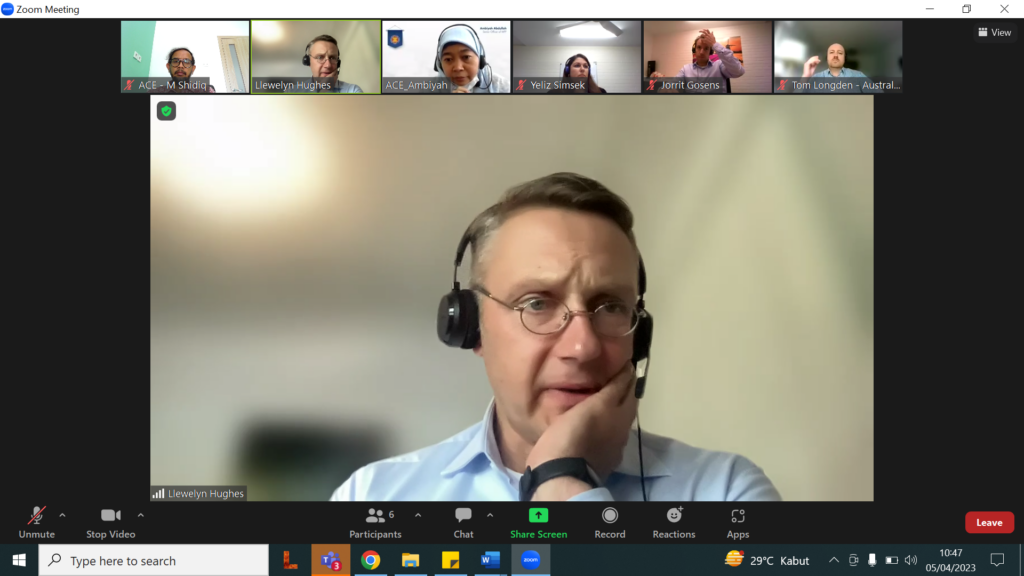Menu
Muhammad Shidiq and Dr Ambiyah Abdullah of ASEAN Centre for Energy (ACE) had an online meeting with Prof Llewelyn Hughes, Dr Thomas Longden, Dr Jorrit Gosens, and Dr Yeliz Simsek of ANU to discuss and explore potential collaboration on energy & climate modelling in the Asia Pacific on Wednesday, 5 March 5, 2023.

Figure 1. ANU and ACE – ACCEPT II representatives during the online discussion on energy & climate modelling
The one-hour online meeting started by explaining the current modelling works that both parties were working on. ACE and ACCEPT highlighted their work on energy modelling for ASEAN Energy Outlook. The outlook is an ACE flagship report on projecting the region’s 2050 energy supply and demand. The outlook used an existing modelling tool, namely the Low Emissions Analysis Platform (LEAP). ACE is preparing to start working on the 8th ASEAN Energy Outlook (AEO8) to be published in 2024. The ANU team has also noted that currently, ACE has two ongoing modelling works with ASEAN Climate Change and Energy Project phase II (ACCEPT II) and EU-COMMITTED. ACCEPT II supports the upcoming AEO to help analyze the region on achieving the net zero target in the future by injecting the net zero scenario. It is expected the AEO analysis may also analyse the climate implication of the energy sector in the region. The COMMITTED project was initially kicked off; the team is designing the work and research plans for the upcoming four years.
The ANU’s colleagues, Prof Llewelyn Hughes and Dr Thomas Longden of Crawford School of Public Policy, and Dr Jorrit Gosens and Dr Yeliz Simsek of Institute for Climate Change, Energy & Disaster Solutions have also elaborated their modelling works on energy and climate context. The colleagues explained that their modelling work used the Global Change Analysis Model (GCAM). GCAM is an integrated assessment model that incorporates the interaction between energy, climate, water, and land use-based factors with socio-economic factors. One of the research projects was to analyse how different decarbonization pathways will affect demand for imports of thermal coal and gas.
As the next research project, the ANU’s colleagues would like to analyse the interaction between ASEAN and Australia on solar, wind and gas energy, for example, which is to be analysed using energy & climate modelling such as GCAM. The model may also consider several technologies, such as green hydrogen and green ammonia. To do so, the GCAM model needs energy and climate data and information for ASEAN specific such as energy, transportation, industry sector and others.
During the meeting, the point of discussion among the parties are:
As follow-up actions to build collaboration, the ANU’s colleagues would like to have a draft joint research proposal and need ACE’s support as a partner in doing the research.
ACE opens for any joint research or collaboration, especially on modelling work. In addition, the ANU’s colleagues will also explore any other partner collaborators for modelling work across the Asia Pacific and mapping out possible funding opportunities overseas. The online meeting summarised that joint research and collaboration are highly possible since the parties work on energy & climate modelling.
Detailed information on ACCEPT II: https://accept.aseanenergy.org/.
For any collaborations with ACCEPT II: [email protected]
